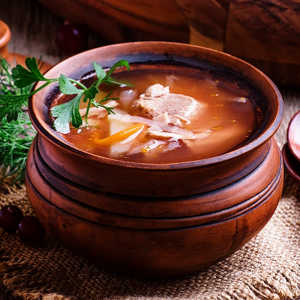Shchi (Щи) Cabbage Soup: A Symbol of Russian Cuisine
 Garanties sécurité
Garanties sécurité
(à modifier dans le module "Réassurance")
 Politique de livraison
Politique de livraison
(à modifier dans le module "Réassurance")
 Politique retours
Politique retours
(à modifier dans le module "Réassurance")
Cabbage Soup: A Symbol of Russian Cuisine
Cabbage soup, or shchi (Щи), is a dish deeply rooted in Russian culture. Neither Tsar Ivan the Terrible, a great fan of sauerkraut soup, nor Napoleon Bonaparte, during his stay at the Kolotsky Monastery before the Battle of Borodino, could resist this iconic dish. According to an anecdote shared by Russian artist Vasili Vereshchagin, Napoleon, after having a bowl of cabbage soup in the monastery's refectory, complimented its flavor before leaving in haste. This episode highlights the significance of this dish, not only in Russian cuisine but also in the history of great figures who have enjoyed it.
Shchi: A Comforting Soup for Winter
At the start of the year, with winter temperatures taking their toll, I’d like to introduce a dish that will warm you up: shchi (Щи). This soup, with its somewhat strange name in French (pronounced "Shchi"), had been on my list for quite a while... and for good reason! It is often considered the rival of Ukrainian borscht. Unlike borscht, which is mainly made with beets, shchi features cabbage as its main ingredient.
Let's explore this curious recipe together, which may surprise more than one person.
An Ancient Russian Tradition
Shchi dates back to the era of Kievan Rus in the 9th century, when peasants began cultivating cabbage. An interesting fact is that the recipe for this soup has changed little over the centuries. Very popular, shchi is deeply embedded in Russian culture, to the point where there are several proverbs dedicated to it, such as: "Где щи, там и нас ищи" (translation: "Where there’s shchi, you’ll find us there").
Historically, this soup was part of the meals for all social classes in Russian society. While nobles added more refined ingredients, the more modest people only had cabbage in their soup. Today, this dish remains extremely popular and is considered the second most beloved soup in Russia, after borscht.
Shchi Recipe: For 3 People
Difficulty: Easy
Preparation: 20 minutes
Cooking time: 1 hour 20 minutes
Ingredients:
- 190 g of pork shoulder (or neck)
- 190 g of white cabbage
- 1 potato
- 1 carrot
- 1 yellow onion
- 70 g of tomato paste
- 2 bay leaves
- 2 garlic cloves (optional)
- Olive oil
- Water
- Sour cream
- Salt / pepper
Shchi Preparation:
- Prepare the broth: In a pressure cooker, add the pork and cover with water. Bring to a boil.
- Simmer the meat: Once the water is boiling, reduce the heat and simmer the meat for at least 1 hour.
- Prepare the vegetables: While the meat is cooking, peel the carrot, potato, garlic, and onion. Set the potato aside.
- Chop the vegetables: Grate the carrot, slice the onion, and mince the garlic. Set them aside together.
- Sauté the vegetables: In a pan, sauté the carrot, onion, and garlic in a bit of olive oil over medium heat for 2-3 minutes.
- Add the tomato paste: Add the tomato paste to the sautéed vegetables, mix well, and cook for 5 minutes, stirring regularly.
- Prepare the cabbage and potato: Slice the cabbage finely and cut the potato into chunks.
- Combine with the broth: Add the cabbage and potato to the pork broth in the pressure cooker. Bring it to a boil again.
- Add the sautéed mixture: Pour the sautéed vegetables and tomato paste mixture into the pot and reduce the heat. Simmer for 20 minutes.
- Season: Add the bay leaves, salt, and pepper. Turn off the heat and let it infuse.
- Serve: Serve hot, adding a tablespoon of sour cream to each bowl for extra richness.
Tips and Observations:
Shchi is a concentrated burst of flavor and nutrients. It can easily be adjusted to suit your tastes by modifying the quantities or substituting some ingredients. For example, you can:
- Add more or less tomato paste,
- Replace fresh cabbage with fermented cabbage for a tangier flavor,
- Add or skip sour cream, depending on your preference.
This dish is not only delicious but also highly nutritious, providing essential nutrients like potassium, calcium, iron, and magnesium, which are perfect for cold winter months. Shchi truly deserves the love it receives in Slavic culture!
How to Refresh with this Dish?
To balance out the warm, comforting nature of shchi, I recommend pairing it with a refreshing drink, such as mineral water or sparkling water. This will provide a pleasant contrast to the warmth of the broth and perfectly complement the meal.
For a more Russian touch, you can also opt for kompot (компот), a sweet fruit beverage, which is refreshing and pairs well with the savory flavor of the dish.
Shchi: Variations and History
Shchi comes in many forms, ranging from simple, rustic versions to richer, more refined ones. You’ll find cabbage soups with tomatoes, chicken, ham, or even sauerkraut. Some versions are clear, while others are thicker and more filling. Depending on the season, region, or occasion, shchi can be prepared in different ways, making it a dish of great diversity. The most famous variations include oven-baked soup, winter soup, and the coachman’s version, but the everyday cabbage soup remains by far the most popular.
In the 19th century, oven-baked cabbage soup became an essential dish in the imperial capital, St. Petersburg. The best taverns in the city, notably Testov’s, served refined versions of this dish, highly sought after by the elite of the time. These soups were prepared with great care, combining simple ingredients and special cooking techniques to achieve a soup that was both flavorful and comforting.
Shchi: An Iconic Dish
In summary, shchi is much more than just a soup. It is a true symbol of the richness of Russian cuisine, a recipe that transcends time and social classes. From tsars to soldiers, from monks to foreign dignitaries, all have found comfort and satisfaction in this dish. Cabbage soup embodies the soul of Russia: a nourishing, simple yet tradition-filled dish.


